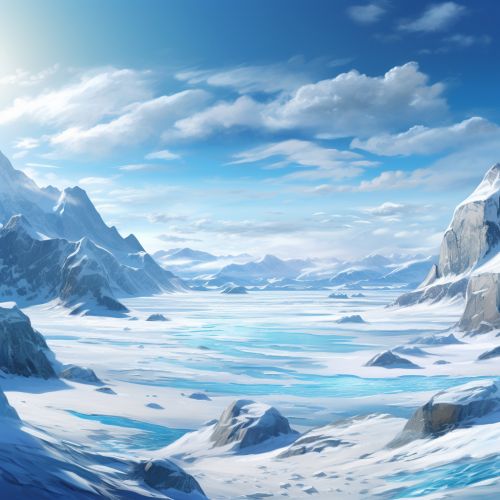Ice Age
Introduction
The Ice Age is a period in Earth's history characterized by long-term reductions in the planet's temperature, resulting in the expansion of continental and polar ice sheets and alpine glaciers. The term "Ice Age" is commonly used to refer to the most recent glacial period, which peaked approximately 21,000 years ago, but it can also refer to the entire Pleistocene epoch, which began about 2.6 million years ago and ended around 11,700 years ago.


Causes of Ice Ages
Ice Ages are primarily caused by long-term shifts in the Earth's orbit and tilt, known as Milankovitch cycles. These cycles alter the amount of solar radiation reaching the Earth's surface, leading to periods of cooling and warming. Other factors, such as the levels of greenhouse gases in the atmosphere and the position of the continents, can also influence the onset and severity of Ice Ages.
Milankovitch Cycles
Milankovitch cycles are periodic changes in Earth's orbit and tilt that affect the amount of sunlight reaching different parts of the planet. There are three main types of Milankovitch cycles: eccentricity, axial tilt, and precession. Eccentricity refers to the shape of Earth's orbit around the sun, axial tilt refers to the angle of the Earth's axis relative to its orbit, and precession refers to the wobble of the Earth's axis. These cycles have periods of approximately 100,000, 41,000, and 26,000 years, respectively.
Greenhouse Gases
The concentration of greenhouse gases in the Earth's atmosphere can also influence global temperatures. During periods of reduced solar radiation, lower levels of greenhouse gases can enhance the cooling effect, leading to the expansion of ice sheets and glaciers. Conversely, higher levels of greenhouse gases can amplify warming periods, leading to the melting of ice and the end of an Ice Age.
Continental Position
The position of the continents can also play a role in the onset and severity of Ice Ages. When continents are located near the poles, they can support the formation of large ice sheets. Additionally, the arrangement of continents can affect ocean currents, which can influence global climate patterns.
Glacial and Interglacial Periods
Ice Ages are composed of alternating glacial and interglacial periods. Glacial periods, or glaciations, are times when ice sheets and glaciers expand across the planet. These periods are marked by colder global temperatures and can last for several million years. Interglacial periods, on the other hand, are warmer periods within an Ice Age when ice recedes and global temperatures rise.
Effects of Ice Ages
Ice Ages have had profound effects on the Earth's climate, geography, and life forms. They have shaped the landscape through the action of glaciers, which carve out valleys and deposit sediments, creating unique geological features. Ice Ages have also influenced the evolution and distribution of species, as organisms must adapt to changing climates and habitats.
Climate and Geography
During an Ice Age, the global climate becomes cooler and drier. Precipitation patterns change, with areas closer to the ice sheets receiving more rainfall. The advance and retreat of glaciers and ice sheets reshape the landscape, carving out valleys, creating lakes, and depositing sediments.
Life Forms
Ice Ages have also had significant impacts on life on Earth. Many species have had to adapt to colder temperatures and changing habitats. Some species, such as the woolly mammoth, evolved adaptations for cold weather, while others migrated to warmer climates. Ice Ages have also influenced human evolution and migration patterns.
The Last Ice Age
The most recent Ice Age, known as the Last Glacial Maximum (LGM), occurred about 21,000 years ago. During this time, vast ice sheets covered much of North America, Europe, and Asia. The LGM had significant effects on the Earth's climate and ecosystems, and its end marked the beginning of the current interglacial period, known as the Holocene.
Conclusion
Ice Ages are major periods in Earth's history, characterized by significant global cooling and the expansion of ice sheets and glaciers. They are caused by a combination of factors, including changes in Earth's orbit and tilt, levels of greenhouse gases, and the position of continents. Ice Ages have had profound effects on the Earth's climate, geography, and life forms, shaping the landscape and influencing the evolution and distribution of species.
